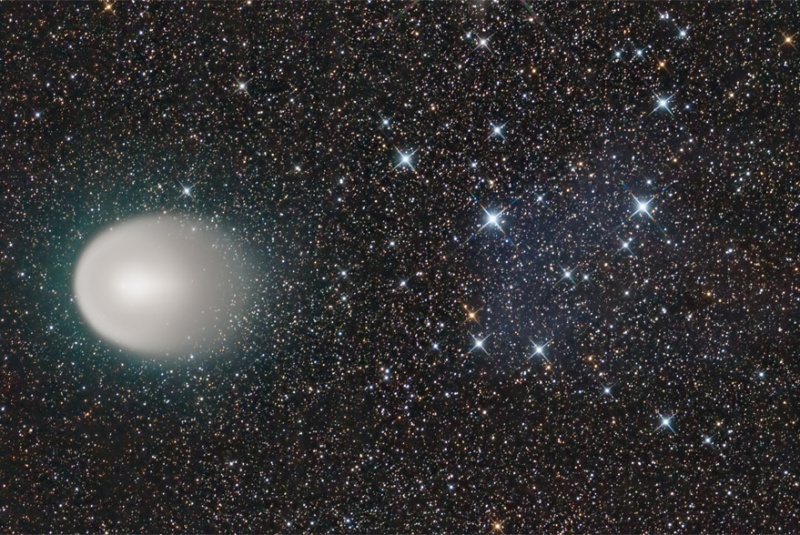
A year ago, Comet 17P/Holmes impressed observers throughout the planet Earth.
An impressive and rapid explosion transformed it from a faint comet peacefully in orbit around the Sun with a period of about 7 years, a comet visible to the naked eye rivaling in brightness with the brightest stars of the constellation Perseus.
His great shape with no tail, as seen in this view taken on Nov. 11, 2007, became well known among astronomers who were trying to unravel the mystery of cometary sudden explosion.
In addition, the Comet Holmes had a weak spool ionized who was separated from the bright light coma.
In this image, separate the tail creates the illusion of a reflection nebula.
Appears as a weak bluish haze in the center right above a background of stars in the Perseus cluster Alpha. 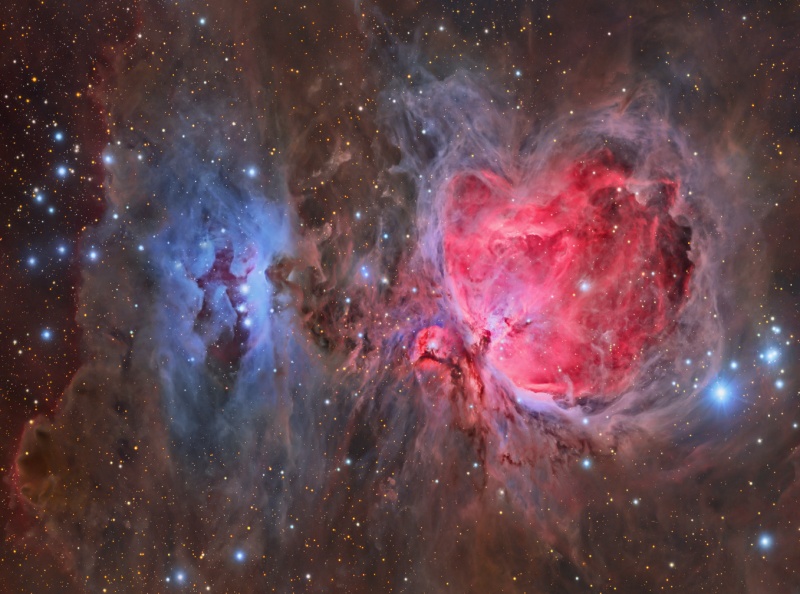
The Great Orion Nebula, also known as M42, is one of the most famous nebulae in the cielo.Las clouds of glowing gas in the region of star formation and its hot, young stars are the stars of the right of this area and detailed colorful mosaic of two images which includes the small nebula M43 near the center and polvierta and blue reflection nebula NGC 1977 and companions to izquierda.Localizada within a complex and largely invisible molecular cloud, these nebulae easy to see represent only a small fraction of a wealth of nearby galactic interstellar material. Within the well-studied stellar nursery, astronomers have also identified what appear to be many solar systems baby. The stunning view encompasses only two degrees, or about 45 light years from the Orion Nebula that is estimated at a distance of 1,500 light years.
The center of the Lagoon Nebula is busy with the awesome spectacle of the formation of stars.
Visible in the upper left, there are at least two long funnel-shaped cloud, about half a separate light-years and that have been formed by stellar winds and intense radiation.
The tremendous brightness of the nearby star, Hershel 36, illuminates the entire area.
Giant walls of red dust mask and other young stars and hot in the area.
The energy of these stars are filtered from the cold dust and gas, which generate large temperature differences between adjacent regions by creating winds that are forming clouds in funnel shaped.
This image, which covers about 5 light-years, was taken in 1995 by the Hubble Space Telescope.
The Lagoon Nebula, also known as M8, is located some 5,000 light-years away towards the constellation Sagittarius.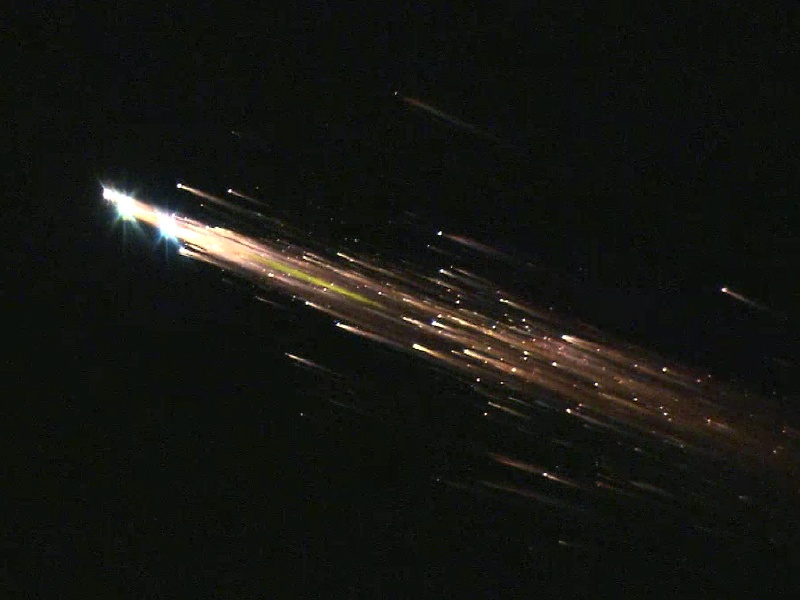
The science fiction writer of the nineteenth century visionary Jules Verne wrote about Travel extraordinary work that included tales of spaceflight and the story of a journey from Earth to the Moon.
Appropriately, the recently developed Automated Transfer Vehicle (ATV) from the European Space Agency, a robotic probe that is expected to provide cargo to the International Space Station (ISS) was named in his honor and successfully docked with the ISS in early year.
When the ATV Jules Verne desatracó and deorbitó the past month, its re-entry to be safely controlled on the Pacific Ocean was followed by astronomers to perform detailed comparisons of that event with computerized models of spacecraft re-entry into Earth's atmosphere.
This impressive picture of fragmentation, 13 tons of sample probe into a snapshot of a high-definition video recorded by the DC-8 Airborne Laboratory of NASA.
The observations were part of the joint ESA / NASA Jules Verne Multi-Instrument Aircraft Campaign.
(these do not understand, they make a probe in honor of Jules Verne and destroyed in the re-entry) 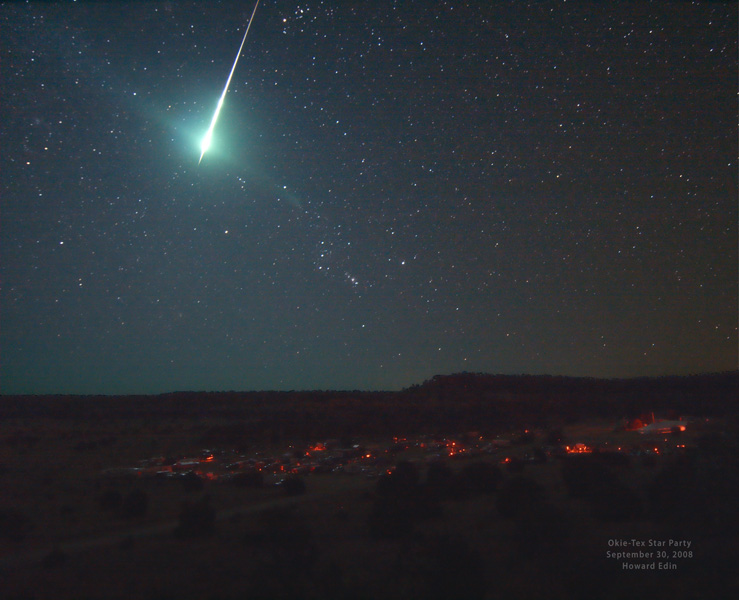
On September 30, a spectacular racing car racing car was struck by a meteor or a group of amateur astronomers to enjoy a dark night in the enclave of Oklahoma's Black Mesa State Park in the Midwest of the United States.
Relumbrando as family constellation Taurus (above) and Orion, the extremely bright meteor was captured by a camera on a hillside next to the Star Party of Okie-Tex (NDT although his translation is "feast of the stars" in the world ASTRONÓMICO " Star Party "is the general appoint to the events of amateur astronomers and amateur observations and other acts).
The amateur Edin Howard said he was looking in the opposite direction at the time, but was lit up as he saw the entire field of observation to believe that someone had turned on the lights in his car.
The fact see such a brilliant racing car, occurred because a space rock vaporizes rushed through the Earth's atmosphere, it really is a matter of luck.
But that could change.
Earlier this week the discovery and monitoring of the small asteroid 2008 TC3 allowed astronomers to predict the date and place of their impacts on the atmosphere.
While none of the observations of the racing car on earth has been informed that the first prediction of impact was confirmed by at least some detections of combustion and bright flashes of Oct. 7 on the north of Sudan.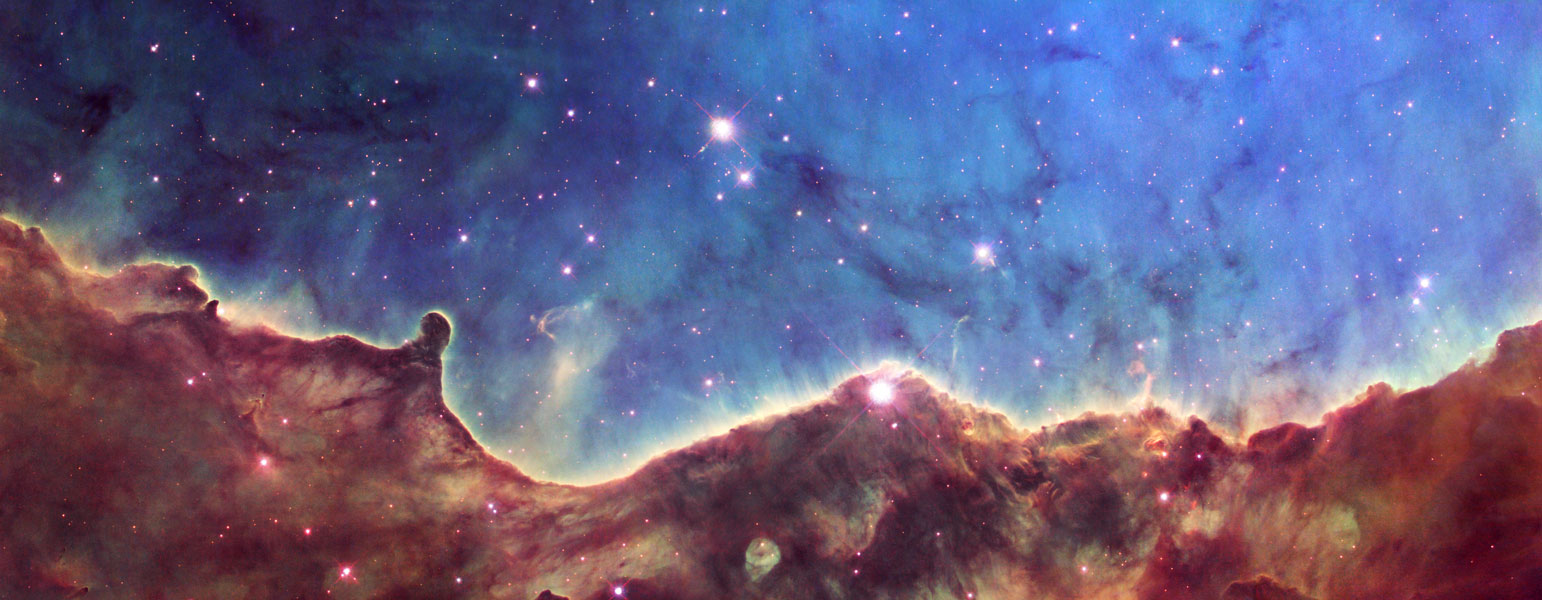
The young and bright stars sometimes sculpt picturesque mountains of dust just born.
Created almost by accident, the energy and light winds from these massive newborn stars burn accumulations of dark dust and cold gas of a slow but persistent.
Such is the case of NGC 3324, a region of star formation near the edge of NGC 3372, the energy expanding Carina nebula.
Depicted above, with a few colors assigned scientifically, is only a small part of NGC 3324.
The Carina Nebula as such is one of the regions of star formation known and largest home of Eta Carinae, one of the most volatile variable stars known.
The picture above was taken from the file of the Hubble Space Telescope in honor of the tenth anniversary of the Hubble Heritage Project.
The Hubble Heritage Project has created, so far, about 130 striking images.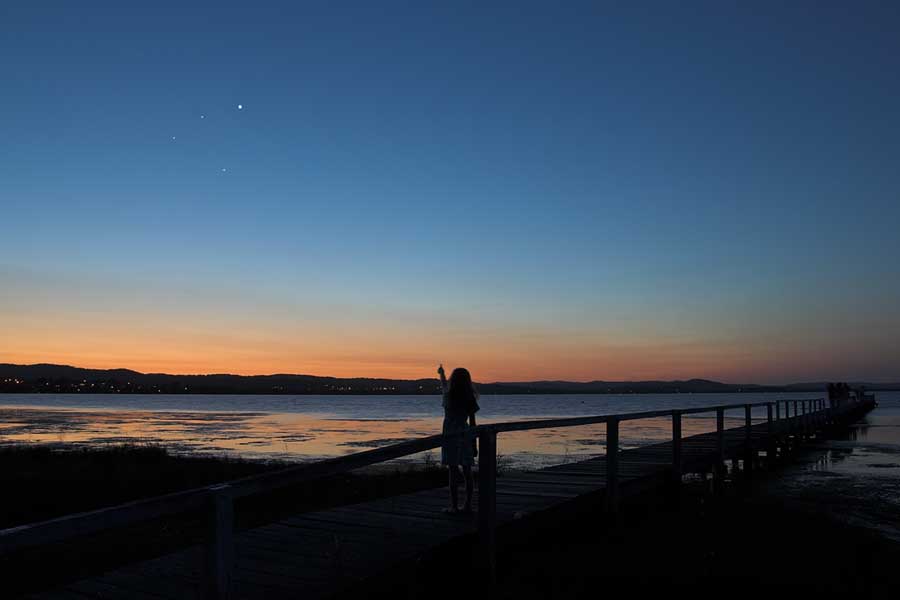
Could you point out the four rocky planets of the Solar System?
In the image above took place on Sept. 20, all of them could be seen in one shot, but some of them may be different as you think.
In the photograph the brightest and high of objects in the sky is the planet Venus.
The aim lower in the sky is the planet Mars, while the farthest to the left is the planet Mercury.
The last point of light that remains is. . . the bright star Spica (or Ear), which leaves us with the following question: where is the fourth plaenta rock?
It would be the Earth itself, specifically from Australia, which can be seen all along the bottom of the image.
Is there somewhere in the world where you can see a sight like this real?
If.
The image above is a simple presentation with a first plane, a fund and a spectacular in between.
Looking at how far we face from the central band of our Milky Way galaxy, with a long exposure.
Much closer, the planet Jupiter is seen as a brilliant point just to the left of the band.
Even more are near the picturesque Buttes and mesas of the National Park of the Canyons in Utah, USA, illuminated by a rising moon.
In the foreground is a cave sheltering a circle of stones of unknown origin called False Kiva.
The cave was briefly illuminated by a flash during long exposure.
The astrofotógrafo Wally Pacholka accounts that we venture into the cave to take this picture was not exactly easy.
In addition, mountain lions were a concern while waiting alone in a night for the right time of the taking. 
For astronomers, the nearby stellar binary system BD +20 307 originally noted for its large amount of dust.
A sufficient amount of warm dust causes the system to appear exceptionally brilliant in lengths from where the infrared.
Naturally, the dust associated with the planetary formation is often detected around young stars, stars with only a few millinos years of age.
But the system BD +20 307 appears to be that you have at least a few billion years, an age comparable to the age of our own Solar System.
The presence of large amounts of hot dust seems to be due to a collision of relatively close objects the size of a planet of the scale of, say Earth and Venus, in the BD +20 307.
With nostalgia for the classic science fiction novel When Worlds Collide, provides a dramatic illustration representation of the catastrophic event.
Ironically, this indirect evidence of a destructive planetary collision could also be the first indication that planetary systems can form around binary systems nearby.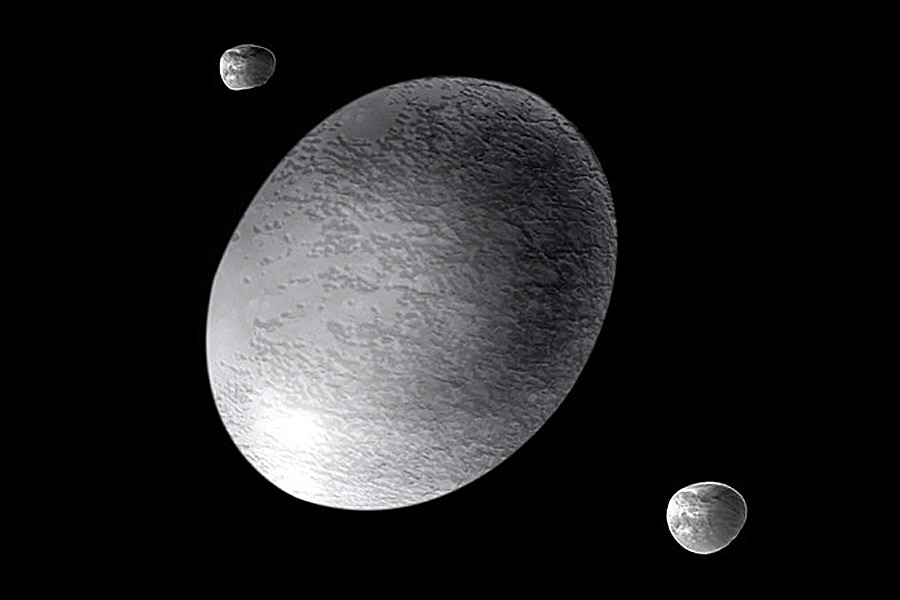
One of the more bizarre objects in the Solar System was exerior classified as a dwarf planet last week and was given the name of Haumea.
This designation makes Haumea of the fifth after dwarf planet Pluto, Ceres, Eris, and makemake.
Haumea looks soft but UAN oblong shape that makes it extremely unusual.
In an address, Haumea is significantly larger than Pluto, but in another, Haumea has an area very similar to that of Pluto, while another third location is much smaller -
Haumea's orbit sometimes brings it closer to the sun that Pluto, but usually Haumea is much further away.
Illustrated above, an artist displayed Haumea as an ellipsoid.
Quite possible, however, Haumea has some interesting features and craters on its surface that still remain unknown.
It was originally discovered in 2003 and was given a temporary desginación as 2003 EL61, but Haumea has been recently renamed by the IAU to honor the Hawaiian gods.
Haumea has two small moons discovered in 2005, recently renamed as Hi'iaka Namakando and in honor of the Brotherhood of divinity.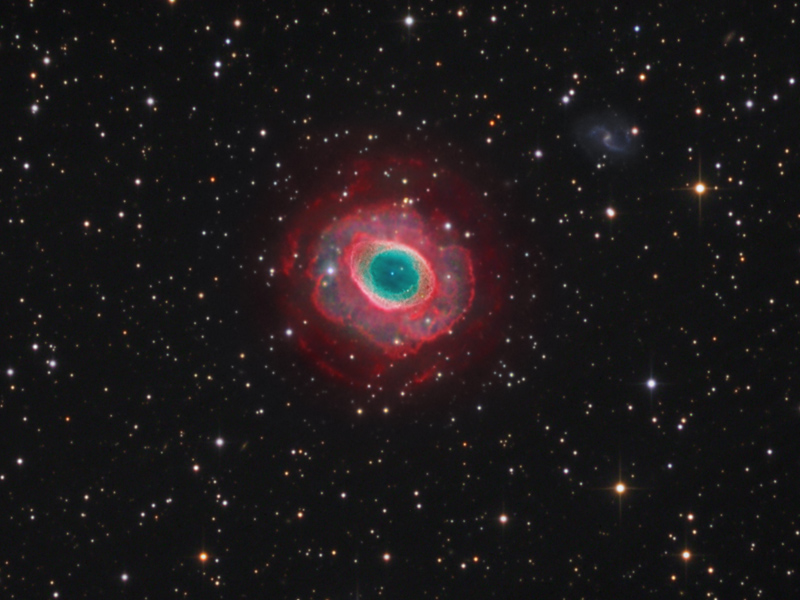
Remains a subject very familiar to astronomers in the northern hemisphere, the Ring Nebula (M57) is about 2,000 light years away in the constellation of musical Lira.
The central ring has a light year or so, but in this extraordinary exhibition, the collaborative effort of combining data from different telescopes, there are filaments of gas resplendent in a loop that extends far beyond the central star.
Certainly in this well-studied example of a planetary nebula, the shiny material is not a planet.
In contrast, the gaseous envelope is the outer layers expelled by a dying star like the Sun.
This composition has 16 hours of data from narrowband done to record emissions from hydrogen atoms in red and the blue tones / green by the emission of oxygen atoms at high temperatures in the ring.
On the right top, you can see the spiral galaxy IC 1296 much more distant. 
At first glance, the Helix Nebula (also known as NGC 7293), seems simple and round.
But this well-studied example of a planetary nebula, produced near the end of the life of a star like the sun, it seems surprising that it has a complex geometry.
Its extensive loops and characteristics of cometary forms have been eexploradas in the Hubble Space Telescope images.
Thus, a telescope of 16 inches in diameter and a camera aboard as well as narrow band filters were used to create this incredible view of the Helix.
The resulting color also reveals intriguing details of the nebula, like light years from the blue-green stretch radio or radios that give the appearance of the spokes of a bicycle wheel cosmic.
These radios seem to indicate that the Helix Nebula is as such an old and evolved planetary nebula.
Helix is at 700 light years from Earth in the constellation of Aquarius.
(how many times we got the story that was the eye of God and appeared every 3000 years ... laure, this always)
NGC 6888, also known as the Crescent Nebula, is a cosmic bubble about 25 light years in diameter, blowing wind of its massive, bright, central star.
This beautiful image combines a telescopic composition of colorful images with data from narrowband to isolate the light of atoms of hydrogen and oxygen from the suction cup nebula.
The oxygen atoms produce green-blue tones that seem to wrap up the detailed folds and filaments.
The star center of NGC 6888 is classified as a star Wolf-Rayet star (WR 136).
The star is losing its outer packaging due to strong stellar winds, eject the equivalent of the solar mass every 10,000 years.
The complex structures of the nebula are the result of this powerful wind interacting with the material eject in the early stages.
The burning of fuel at this pace near the end of his stellar life should ultimately result in a spectacular supernova explosion.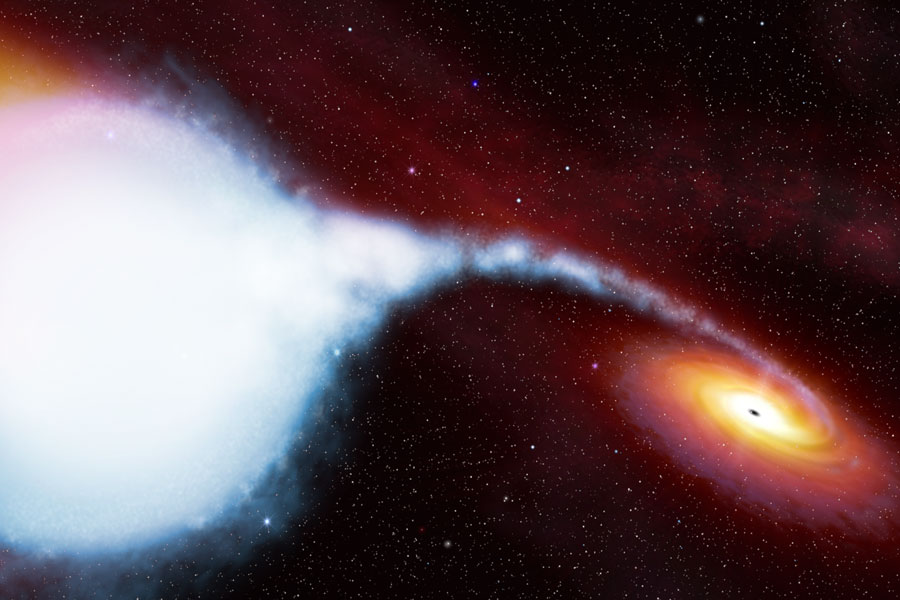
Is this a black hole?
Bastane possible.
The stellar binary system Cygnus X-1 is one of the best candidates to host a black hole.
The scheme was discovered because it is one of the brightest sources of X rays from the sky with a brilliance so potent that was detected with the first carrier rockets of cameras able to see the previously unknown X-rays in the sky.
Her name tells us so easy that it is the single most brilliant source of X-rays in the constellation of the Swan.
The data indicate that an object contains compact there about nine times the mass of the Sun and continually changes its brightness several times in its scale, at least in a few milliseconds.
This behavior is typical of a black hole, and difficult to explain to other models.
The image above is an artistic impression of Cygnus X-1.
On the left estla and the brilliant blue star supergigante designated as HDE 226868, whose Maya is estimated at about 30 times that of our Sun.
Cygnus X-1 is depicted on the right, connected with his companion supergigante by a flow of gas, and surrounded by an impressive accretion disk.
The bright star in the Cygnus X-1 is visible with a small telescope.
Rarely, the candidate of a black hole Cygnus X-1 appears to have formed without any brilliant supernova explosion. 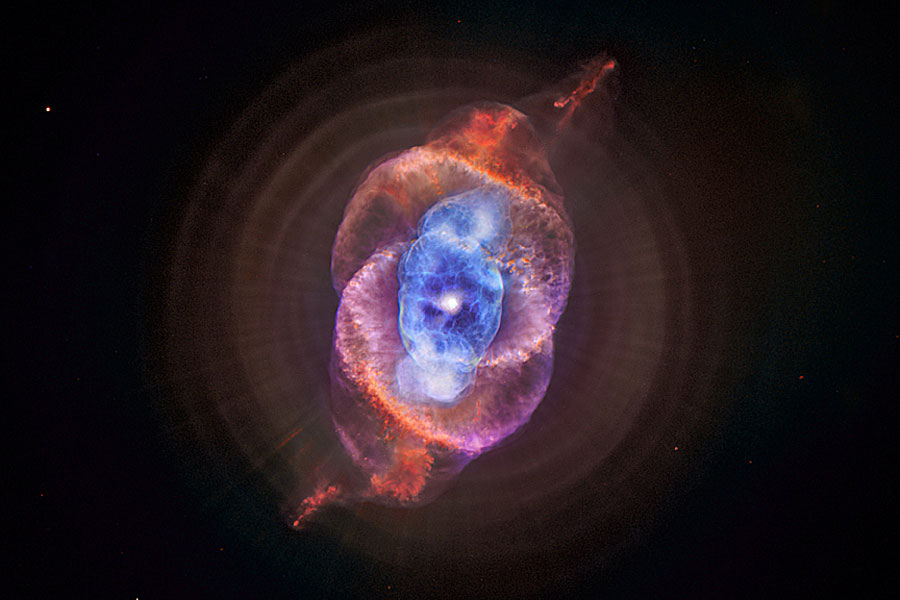
The evocative shapes of the planetary nebula NGC 6543 suggest at a glance its popular nickname - the Cat's Eye Nebula.
In 1995, a striking image of false color optical space telescope Hubble detailed the eddies of this glowing nebula, which is known to be the envelope of a dying solar-type star, about 3,000 light years from Earth.
This composite image combines the famous photograph of the Hubble with new data from x-ray Space Observatory and Chandra reveals that, surprisingly, there is intense emission of X-ray indicating the presence of very hot gas.
The x-ray emission is shown in shades of blue and purple superimposed over the red and green optical emission. Even the central star of the nebula is clearly immersed in gas emitter large amount of X-ray
Other pockets of hot gas in x-rays are surrounded by cooler gas that emits very strongly in visible wavelengths, a clear sign that the hot gas in expansion is forming filaments and structures visible from the Cat's Eye Nebula.
Noting the interior of the nebula, astronomers can see the fate of our Sun, which comes into its own phase of planetary nebula, following its evolution, ... within about 5,000 million years.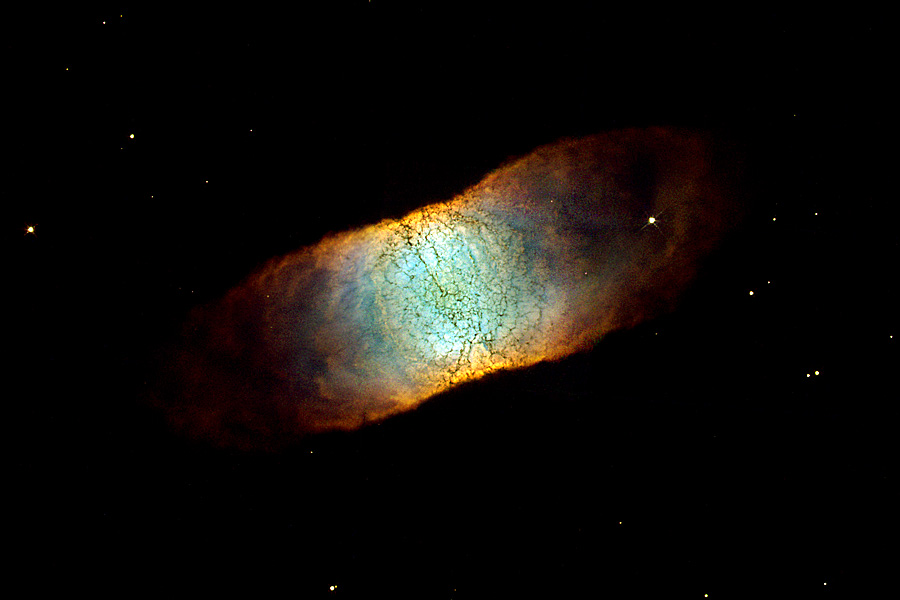
How can a spherical star forming a rectangular nebula? This is the problem that is presented to astronomers who study planetary nebulae such as IC 4406. All the evidence indicates that the IC 4406 is quite possibly a hollow cylinder. Its rectangular shape is because, from our point of view, we see this cylinder from the side. If we could see from its axis, the IC 4406 will have a similar appearance to that of the ring nebula.
The representative color image is a mosaic composed of a combination of images taken from the Hubble Space Telescope in 2001 and 2002. The hot gas escapes through the poles of cilidro, while the walls between the poles are a mixture of dark filaments of dust and gas molecules. The main star responsible for this interstellar sculpture is at the center of the nebula. In a few million years, the only visible remainder of the IC 4406 will be a white dwarf whose brightness will decline irreversibly.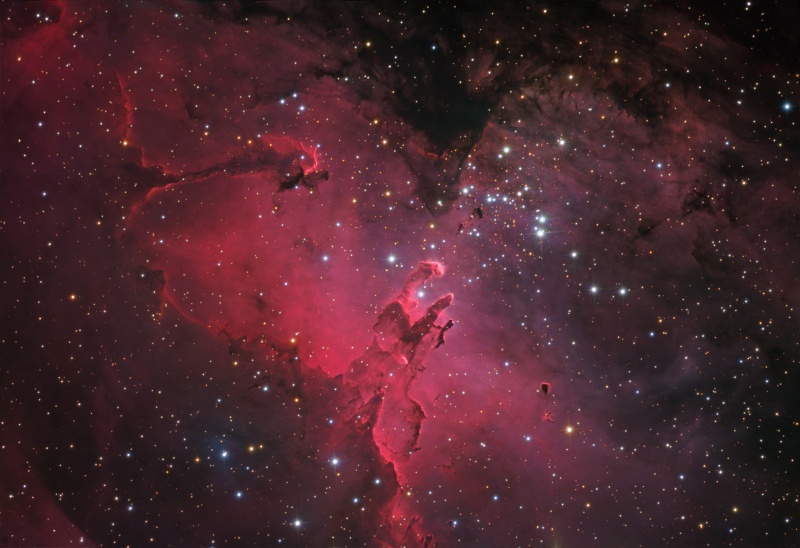
The young star cluster M16 is surrounded by clouds of cosmic dust and hometowns glowing gas also known as the Eagle Nebula.
This beautiful image of the region includes fantastic shapes and famous in the well-known photographs from the Hubble Space Telescope detail of this complex of stars in formation.
Described as an elephant or tubal Pillars of Creation, the dense and dusty columns that rise near the center are light years in length but in gravitational contraction to form stars.
The radiation energy of the wealth of material eroded stars near the ends, possibly exposing new stars.
Extending from the upper left corner of the nebula is another column of dusty star formation known as the Fairy of the Eagle Nebula.
M16 and the Eagle Nebula lies about 7000 light years away, and are an easy target for binoculars or small telescopes in a part of the sky rich in nebulae in the constellation Serpens heading cauda (tail of the snake).
Friday, May 21, 2010
Beauties of space(Very Very Rare)
Posted by HASAN MAHMUD LIMON at 1:06 AM
Subscribe to:
Post Comments (Atom)

0 comments:
Post a Comment